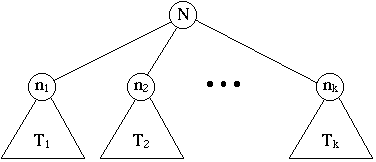CMSC 202 Lecture Notes: Trees
These notes discuss trees in general, not just binary trees.
Some basic terminology for trees:
- Trees are formed from nodes and edges. Nodes are
sometimes called vertices. Edges are sometimes called
branches.
- Nodes may have a number of properties including value and
label.
- Edges are used to relate nodes to each other. In a tree, this
relation is called "parenthood."
- An edge
{a,b} between nodes a and
b establishes a as the parent of
b. Also, b is called a child of
a.
- Although edges are usually drawn as simple lines, they are really
directed from parent to child. In tree drawings, this is
top-to-bottom.
- Informal Definition: a tree is a collection of
nodes, one of which is distinguished as "root," along with a relation
("parenthood") that is shown by edges.
- Formal Definition: This definition is "recursive" in
that it defines tree in terms of itself. The definition is also
"constructive" in that it describes how to construct a tree.
- A single node is a tree. It is "root."
- Suppose N is a node and T1, T2, ..., Tk
are trees with roots n1, n2, ...,nk, respectively.
We can construct a new tree T by making N the parent of the nodes
n1, n2, ..., nk. Then, N is the root of
T and T1, T2, ..., Tk are subtrees.

The tree T, constructed using k subtrees |
More terminology
- A node is either internal or it is a leaf.
- A leaf is a node that has no children.
- Every node in a tree (except root) has exactly one parent.
- The degree of a node is the number of children it has.
- The degree of a tree is the maximum degree of all of its nodes.
- Definition: A path is a sequence of nodes
n1, n2, ..., nk such that node
ni is the parent of node ni+1 for all 1 <= i <=
k.
- Definition: The length of a path is the number of
edges on the path (one less than the number of nodes).
- Definition: The descendents of a node are all the
nodes that are on some path from the node to any leaf.
- Definition: The ancestors of a node are all the
nodes that are on the path from the node to the root.
- Definition: The depth of a node is the length of
the path from root to the node. The depth of a node is sometimes
called its level.
- Definition: The height of a node is the length of
the longest path from the node to a leaf.
- Definition: the height of a tree is the height of
its root.

A general tree, showing node depths (levels) |
In the example above:
- The nodes
Y, Z, U,
V, and W are leaf nodes.
- The nodes
R, S, T, and
X are internal nodes.
- The degree of node
T is 3. The degree of node
S is 1.
- The depth of node
X is 2. The depth of node
Z is 3.
- The height of node
Z is zero. The height of node
S is 2. The height of node R is 3.
- The height of the tree is the same as the height of its root
R. Therefore the height of the tree is 3.
- The sequence of nodes
R,S,X is a path.
- The sequence of nodes
R,X,Y is not a path because the
sequence does not satisfy the "parenthood" property (R
is not the parent of X).
- Definition: A binary tree is a tree in which each node has
degree of exactly 2 and the children of each node are distinguished as
"left" and "right." Some of the children of a node may be empty.
- Formal Definition: A binary tree is:
- either empty, or
- it is a node that has a left and a right subtree, each of
which is a binary tree.
- Definition: A full binary tree (FBT) is a binary
tree in which each node has exactly 2 non-empty children or exactly two
empty children, and all the leaves are on the same level. (Note that
this definition differs from the text definition).
- Definition: A complete binary tree (CBT) is a FBT
except, perhaps, that the deepest level may not be completely filled.
If not completely filled, it is filled from left-to-right.
- A FBT is a CBT, but not vice-versa.

A Binary Tree.
As usual, the empty children are not explicitly shown.
|

A Full Binary Tree. In a FBT, the number of nodes at level
i is 2i.
|

A Complete Binary Tree.
|

Not a Complete Binary Tree. The tree above is not a CBT because the deepest
level is not filled from left-to-right.
|
Thomas A. Anastasio, Tue Oct 28 11:01:25 EST 1997
Modified some by Richard Chang, Tue Apr 28 12:43:27 EDT 1998.






